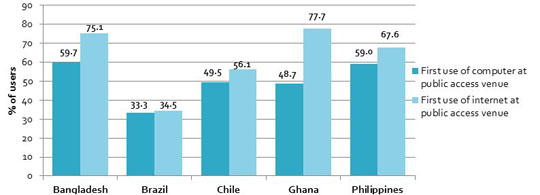Public access venues provide first experience with computers and Internet for many
Over the next several months, leading up to the release of our final project report, the Global Impact Study will be posting interim findings as they emerge from the data. We will begin the series of posts with some findings detailed in our recently released user profiles working paper.
Do you remember where you first used a computer? Where you first used the Internet? School, work, maybe even at home? Findings from our user survey indicate that, with the exception of Brazil, around half of public access ICT users first used a computer at a public access venue, such as a cybercafe, telecenter, or library. More impressive is that between 55%-75% of users first used the Internet in a public access venue, even in Chile, where connectivity is high. In Brazil, with the lowest percentages, over a third of users first used a computer and the Internet at a public access venue.

This data illustrates that public access venues provide many people with their first opportunity to enter the digital age and gain experience with computers and the Internet. The percentages in the chart are higher than we expected as we had hypothesized that schools would be a point of first touch for the majority of new users. This finding has implications for the types of experiences these people have since public access venues are places where people typically engage in multiple, unstructured, and informal activities, not formal classroom learning.
In the coming posts, we will explore where else people use the Internet and computers, what they do in public access venues, their demographic profiles, and more. Stay tuned!
Source: Sciadas, G., with Lyons, H., Rothschild, C., & Sey, A. (2012). Public access to ICTs: Sculpting the profile of users. Seattle: Technology & Social Change Group, University of Washington Information School.


